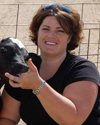
Give Your Heifer Barns Some Attention Too
 By Ann Hoskins
By Ann Hoskins
Transitioning a calf from its individual pen to a group pen can be very stressful. We always say three strikes and you’re out. That can really hit home for your transition calves. Stressors that affect these animals include new location, socializing, feed change, locating feed and water, vaccinations, dehorning, etc. Expose them to too many stressors at once, and you’ll significantly miss out on heifer health and performance. At this stage, calves should be comfortably consuming 5 to 6 pounds of grain daily. In most cases, calves will go off feed for a couple of days when they’re exposed to too much stress. This can result in cocci breaks, respiratory disease and weight loss. The first signs that calves are stressed are usually inconsistent manure, rough hair coats, coughing and too much feed refusal. It is fairly easy to change the schedule of events for dehorning, vaccinating and feed changes to pre-moving or post-moving. But have you ever taken a close look at the facility that will be the calves new home? Is it user-friendly to the calf? I challenge you to look at your animals’ behavior for the first few days when you move them to group housing. How is the calf flow? Can they find the feed easily? Is it easy to reach the feed? Can calves easily reach and find the water source? Do they have to figure out how to use headlocks or slant bars for the first time? Each of these challenges alone could be a single stressor. Add them up and you could be on path for disaster. The biggest challenge I see is calves is finding the feed and water. Try to keep feed and water along the fence line. When calves enter a pen, they always walk the perimeter first. If you look at a pasture, the grass on the fence line is always eaten first. This can be as simple as putting in a portable bunk for the first week until they learn to stick their heads through the head locks or slant bars. In some cases, a raised bunk in the feed alley may help. When looking at your feeding areas, look at throat height, curb width, elevation difference between the feeding table and the scrape alley and/or bed pack. Signs that the calf is struggling or uncomfortable include:
- Bare areas of skin where hair is rubbed off from stretching
- The calf’s neck is stretched for an uncomfortable reach to the feed
- The calf’s head is getting stuck frequently due to the wrong size slant bars or headlocks
Make sure your water height is appropriate for the size of animal you have in the pen. Consider the height of the water plus the pad it is on. Sometimes I see calves struggling to reach the water. In most cases, they figure out how to reach the water to survive, but the amount they will drink is limited. I would encourage you to look at your transition areas and see if you can make some small adjustments that, in turn, make calves’ transition just a little smoother. This article originally appeared in the August 2012 edition of Starting Strong, the Vita Plus calf care e-newsletter. For more practical calf care tips and technical expertise, visit startingstrong.vitaplus.com. Subscribe to receive the bi-monthly e-news straight to your inbox. About the author: Ann Hoskins is the Vita Plus calf products manager. She grew up on a dairy farm in DeForest, Wis., which she says is instrumental to where she is today. “The lessons and values I gained growing up in this industry have given me the passion to stay involved and continue to learn more every day.” Hoskins earned her bachelor’s degree from the University of Wisconsin-Madison and has spent that last five years at Vita Plus, working with producers to improve performance and help them reach the goals of their calf operations.
| Category: |
Cow comfort Dairy Performance Facility design |

